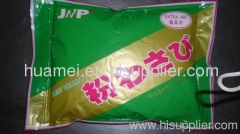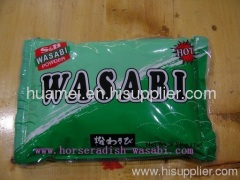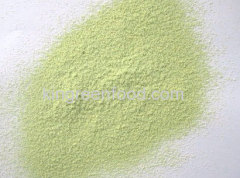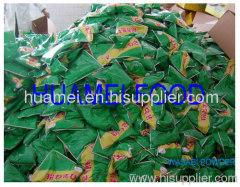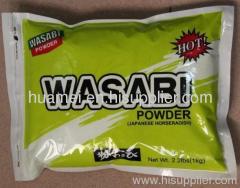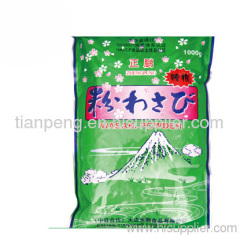
Japanese wasabi powder
2000.0~3000.0 USD
| Min. Order: | 3 Ton |
|---|---|
| Trade Term: | FOB |
| Payment Terms: | L/C, T/T |
| Supply Ability: | 500ton/year |
| Place of Origin: | Shandong |
Company Profile
| Location: | Rizhao, Shandong, China (Mainland) |
|---|---|
| Business Type: | Manufacturer, Trading Company |
Product Detail
| Means of Transport: | Ocean |
|---|---|
| Brand Name: | hm |
| color: | green |
| Production Capacity: | 500ton/year |
| Packing: | 42g/tube |
| Delivery Date: | 20days |
Product Description
1 Specifications 1kg/bag 10bags/CTN
2 Durability:2year
3 ingeredients: wasabi powder, mustard powder, corn starch, fd&c bule and yellow
2 Durability:2year
3 ingeredients: wasabi powder, mustard powder, corn starch, fd&c bule and yellow
4 Case Dimension 410mm 320mm 180mm
5 20 Feet Container 1150CTN
6 N.W. 10KG G.W
HOW TO PREPARE WASABI
1 MEASURE : WASABI POWDER 1CUP WATER 3/4 CUP ,SLOWLY ADD COLD WATER AND MIX WELL
2 KEEP THE PREPARED WASABI IN AN AIRTIGHT CONTAINER TO MAINTAIN IT
3 FOR BEST FLAVOR,SERVE WASABI 3HOURS AFTER PREPARED
4 RESEAL PACKAGE BY FIRMLY CLOSING THE ZIPPER AND STORE IN A COOL DRY PLACE
WASABI
Wasabi is sometimes called Japanese horseradish, and its taste is very similar. However, real wasabi - wasabia japonica - is a relative of the family and an elusive little root. Like horseradish, it is a root, or , and it is grated or sliced for use in cooking. Wasabi is difficult to find because it is difficult to grow. It is expensive to buy because it is expensive to grow.
Wasabi is a fussy little plant, and has to be nurtured and brought carefully along like a delicate child. It takes about 18 months to reach its mature height of about 6 inches (36cm). Wasabi requires a constant stream of cool water, but not too cool; shade, but not too much shade; and a mild climate. Thus, the United States is not ideal wasabi-growing country, except in the Pacific-Northwest, where growers have had some success with the plant. It is also grown successfully in New Zealand, as well as in Japan.
may seize anyone who buys a genuine wasabi root. A single root may cost US$8-$10, and wasabi roots run about US$70-$100 per pound, depending on where the root was grown. Some Asian markets in larger cities may have fresh, genuine wasabi roots for sale, and a shopper will know he has the genuine article by the price .
When the wasabi is finally secured, it is prepared for eating raw by washing it, trimming any bumpy or scaly parts off with a sharp knife, and then grating it in a circular motion. A fine metal grater, such as a lemon zester, may be used, but real wasabi gourmands insist on a sharkskin grater, which they say produces a velvety grind. The grated wasabi is gathered into a ball and left to sit for a couple of minutes, to allow the heat and flavor to develop, then it is eaten. The traditional use is to eat it with sushi or sashimi, but it also may be used to flavor mustard or , as a meat sauce, or in salad dressings.
For those who simply cannot afford the genuine root, most cooks say the wasabi powder available in supermarkets will work nearly as well as the wasabia japonica.
The horseradish root is a close relative to and contains an eye-watering that produces the heat and spice for which horseradish powder is known. This , present in both mustard and horseradish, is called allyl isothiocynate. When the horseradish is not dried and powdered right away, the chemical begins to degrade and may produce a bitter rather than a hot taste.
Normally you'll use horseradish powder in sauces and dips that aren't cooked. Cooking tends to break down the oil present in the horseradish powder and produces less heat. On the other hand, if you’d like a little bit of the flavor of horseradish without too much spiciness, you can use a bit of the powder in cooked sauces.
Perhaps one of the most happy marriages in the US and UK is beef, like roast beef or prime rib, served with a side of horseradish sauce. When you have horseradish power on hand, you can make your own sauce, which will often taste much fresher than the various horseradish dips you can purchase in stores. Merely add horseradish powder to either sour cream or crème fraiche in order to make a delicious and spicy sauce to accompany beef.
Another relative of the cabbage family that many find comparable to horseradish is . This is often called Chinese, Japanese, or simply Asian horseradish sauce. Usually, wasabi is not sold in powdered form. You either buy it in tubes, or grate fresh wasabi. Like horseradish powder, wasabi is very spicy, and contains isothiocynates. Wasabi powder does not usually contain horseradish and is instead a mix of powdered horseradish, green and mustard.
Look for the powder of horseradish next to other spices in local grocery stores. It might also be sold next to the ’s section or meat section of a store. If you’re looking for wasabi, be sure to read the labels carefully to make sure you’re buying the "real" wasabi, You may locate this in the ethnic foods section of your grocery store, or in Asian grocery stores.


